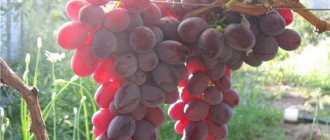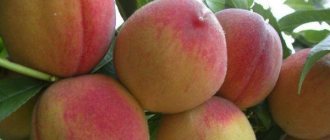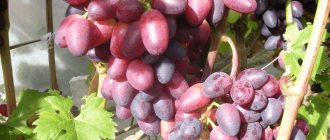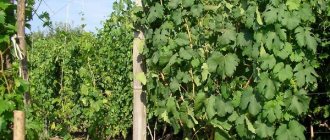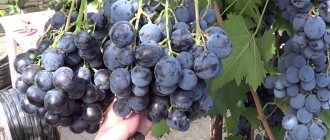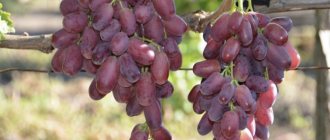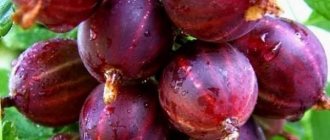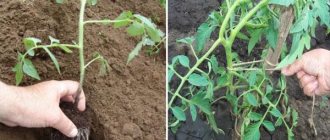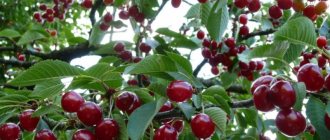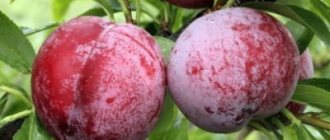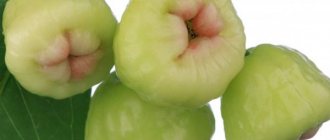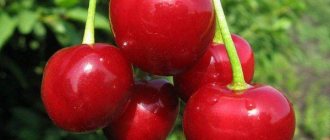Description
The description states that the Golden Jubilee peach is a table variety; the photo shows that it is a medium-height tree with a spreading crown. It grows quickly, reaching a maximum height of 5 m in a few years. The leaves are wide, yellow-green, with jagged edges. The flowers are bright pink, medium in size, bell-shaped, concave petals. Flowering is abundant and occurs in mid-May. The ovary is formed well.
The variety bears fruit in the fourth year of cultivation. Golden Jubilee peaches are large, average fruit weight 140 g, round with an oval top. The skin is medium thick, honey-colored with a characteristic blush. The pubescence is not strong. When cut, the flesh is bright orange, fibrous, sweet and sour, juicy. The stone is small, brown-red in color, easily separated. The stalk is small.
Important! To grow peaches weighing up to 300 g, you need good feeding.
The Golden Jubilee variety is zoned for the North Caucasus region. However, it showed good results when grown not only in dry and hot climates. It is successfully cultivated in damp and humid regions. The variety adapts well to any climatic conditions.
Are there any disadvantages to the variety?
There is no ideal type of wood; they all have their own disadvantages that must be taken into account. What are the disadvantages of the Golden Jubilee peach?
- The tree's winter hardiness is good, but in the middle regions it still needs to be insulated for the winter, and in the northern regions, most likely, it will freeze out in the first winter.
- Transportability is not the best. Ripe peaches become covered with dark spots and dents after transportation. If you need to transport fruits over long or short distances, they need to be picked a week before ripening and packed tightly in layers in boxes. Only in this case the quality of the fruits sold after transportation can be good.
Ripe peaches become covered with dark spots and dents after transportation.
Characteristics of the Golden Jubilee peach variety
The Golden Jubilee peach is loved by gardeners due to its characteristics. It is hardy, with good immunity and stable yield.
Drought resistance, frost resistance
The variety tolerates temperature drops down to -25 °C without serious consequences. The winter hardiness of flower buds and shoots is high. The tree is resistant to return frosts. Winters well in the steppe regions of Crimea, where winters are snowless. In the conditions of the middle zone and in the North, it is not worth growing without additional shelter for the winter.
Peach adapts well to hot conditions and does not require special care during the dry period.
Does the variety need pollinators?
The Golden Jubilee variety is completely self-fertile, but the yield without cross-pollination is lower than stated. To collect a lot of tasty fruits, you need to grow trees in the garden with a suitable flowering period.
Good pollinators for the Golden Jubilee variety:
- Stavropol pink;
- Harnas;
- Volcano;
- Inka.
Alone, they bear fruit unstably; when planted together, the results are much better.
Productivity and fruiting
The Golden Jubilee peach is very productive. With age, the indicators only increase. The average yield of a ten-year-old tree is within 50 kg. It is possible to collect up to 65 kg of fruits, but for this you need to properly care for the variety.
Important! In unstable climates, the yield is much lower, and the taste of the fruit is worse.
The Golden Jubilee peach variety bears fruit in the first half of August. The photo shows that the fruits are of high quality. The yield of the harvest is friendly; peaches must be collected within a week, otherwise they will fall off. Ripe fruits do not stick well to the branches.
Golden Jubilee peaches are fragrant, excellent taste, and have good commercial characteristics. The variety is suitable for industrial cultivation.
Area of application of fruits
The fresh harvest is stored for no more than 5 days, so it is immediately processed. The variety is suitable for whole-fruit canning, making jams, compotes, and drying.
Ripe peaches are poorly transported; they cannot be transported over long distances. The fruits quickly lose their presentation.
Resistance to diseases and pests
The Golden Jubilee tree is highly resistant to disease. He is not afraid of such diseases:
- powdery mildew;
- Clusterosporiosis.
However, the variety is severely affected by leaf curl. Needs preventive treatments.
Important! Peach is often affected by pests.
Advantages and disadvantages of the variety
Among the advantages of the Golden Jubilee variety are high yields, good commercial quality of the fruits and their taste. The immunity and winter hardiness of peach depend on care.
Despite its good characteristics, the variety has a number of disadvantages that you need to know about before planting it:
- Low transportability of fruits and short shelf life.
- The tendency of the crop to shed.
- Average winter hardiness for northern regions.
- The need for preventive treatments against pests and diseases.
In general, the Golden Jubilee variety takes root well and grows in different regions of the country, but this requires some effort.
Pros and cons of the variety
The key advantages of the variety include the following:
- Early onset of fruiting. The tree begins to bear fruit 3-4 years after planting.
- High yield. It can reach 60 kilograms.
- Good commercial quality. Peaches of this variety have an attractive appearance and pronounced aroma.
- High winter hardiness. The culture can withstand frosts down to -25 degrees.
- Disease resistance. The plant practically does not encounter fungal infections.
At the same time, culture is not without its disadvantages:
- The need for insulation in the Middle Zone. The plant cannot be grown in northern regions as it will freeze.
- Not very good transportability. After transportation, ripe peaches become stained. Therefore, if it is necessary to transport over long distances, peaches should be picked in advance.
- The need for quality care. If agrotechnical recommendations are not followed, the fruits may become tasteless and the yield of the plant will decrease.
- Tendency to shedding. Ripe peaches can stay on the tree for a maximum of 3 days. After which they fall off and deteriorate.
Rules for planting peach
The Golden Jubilee peach variety can be grafted onto almonds and cherry plums, and the tree bears fruit equally well. Experienced gardeners recommend using apricot as a rootstock.
Recommended timing
In the recommended regions, Golden Jubilee peach planting is planned for the fall. In the middle zone, the variety is planted in early spring.
The main rule is to plant a tree when it is in its dormant period. In the spring before the sap begins to flow, in the fall - after leaf fall.
Choosing a suitable location
It has been noticed that the Golden Jubilee peach grows well and develops only on loose, sandy loam or loamy soils.
The landing site is chosen to be quiet, windless, well-lit, and with low groundwater levels. The southern, southwestern or western side of the site is ideal. It will be good if one side of the tree is surrounded by a fence, wall or other buildings.
Important! When planting, avoid low-lying and swampy areas. Overwatering causes the roots to hurt.
Selection and preparation of planting material
Further fruiting and viability depend on what the seedling is like. When choosing planting material, you need to pay attention to the following factors:
- root system;
- skeletal branches;
- vaccination site;
- age of the tree.
For planting, choose an annual seedling with a well-developed root system. This type of plant takes root best. The roots should be without visible damage, not dry, not affected by disease, and white when cut. The skeletal branches of the tree are symmetrical.
Particular attention should be paid to the vaccination site. A good root collar is solid, without sagging or sap.
If transportation is to be carried out, the peach roots are wrapped in damp cloth and packed in a bag. Before planting, the seedling is soaked for 12 hours in a bucket of water so that the shoots are saturated with moisture.
Important! In autumn, the seedlings are not soaked before planting.
Landing algorithm
The pit for planting is prepared in advance. Its standard size is 50 x 50 cm. The area is dug up, mineral fertilizers and organic matter are added. It is advisable to use ash, manure, superphosphate.
When starting planting, fertile soil is mixed with complex mineral fertilizers. The seedling is placed in the center of the hole, the roots are straightened and sprinkled with soil. Pack well and water abundantly. The tree trunk circle is mulched with humus or straw.
Peach aftercare
Peach roots need access to oxygen. The tree trunk circle is regularly loosened and freed from weeds. The rest of the care is standard.
Watering is carried out several times a season, abundantly wetting the soil. If the weather is rainy, then there is no need to additionally moisten the soil. Enough natural moisture.
For abundant fruiting, fertilizing is used. They are introduced in the second year after planting, if the pit has been filled according to all the rules. Preference is given to phosphorus-potassium fertilizers.
To increase winter hardiness and productivity, the crown must be trimmed. Formation is carried out throughout the season. In the spring they prune “at the pink bud”, then in mid-summer and after harvesting.
In the spring, dry, broken, twisted branches are cut out. Rejuvenate old peaches. In the summer, sanitary cleaning is carried out, diseased and thickening shoots are removed. In the fall, the crown is formed and branches broken from the harvest are removed.
After harvesting, the tree is prepared for winter. The trunk is cleared of old bark, all wounds and cracks are covered with garden varnish, and treated with lime with the addition of copper sulfate. In late autumn, moisture-charging watering is carried out so that the roots and shoots do not dry out in winter. To do this, the soil around the seedling is generously moistened with water to a depth of 50 cm.
Important! In the northern regions in the middle zone, the trunk is additionally insulated and the trunk circle is mulched with organic matter. The thickness of the mulch layer is up to 15 cm.
Diseases and pests, methods of control and prevention
The Golden Jubilee peach is often affected by curliness. In the photo you can see what the tree looks like. The disease is dangerous and can destroy the peach completely. To prevent this from happening, you need to carry out preventive treatment with copper-containing preparations. Spraying is done in early spring and autumn. It is allowed to use 3% Bordeaux mixture, copper sulfate and the following drugs:
- "Oxychom";
- "Raek";
- "Skor."
In addition, these remedies have a complex effect and will help get rid of other diseases.
To prevent pests, spray with complex insecticides.
When to harvest and how to store the crop?
In southern latitudes, the Golden Jubilee peach variety is harvested in early August, and in the middle regions much later, depending on the weather. If the summer is cool and rainy, the fruits will ripen in the middle or at the end of the month.
It is not recommended to keep fruits on trees. Ripe peaches should be picked immediately, as the variety is characterized by a tendency to shed fruit. The harvest can last up to 8 days, and if it is harvested a week earlier, then up to 20 days.
The key to successful peach cultivation: choosing the right variety to ensure stable yields. Therefore, for gardeners who trust quality, the Golden Jubilee peach remains one of the favorite varieties. After all, its positive characteristics and varietal characteristics can satisfy all the requirements of modern gardening.
